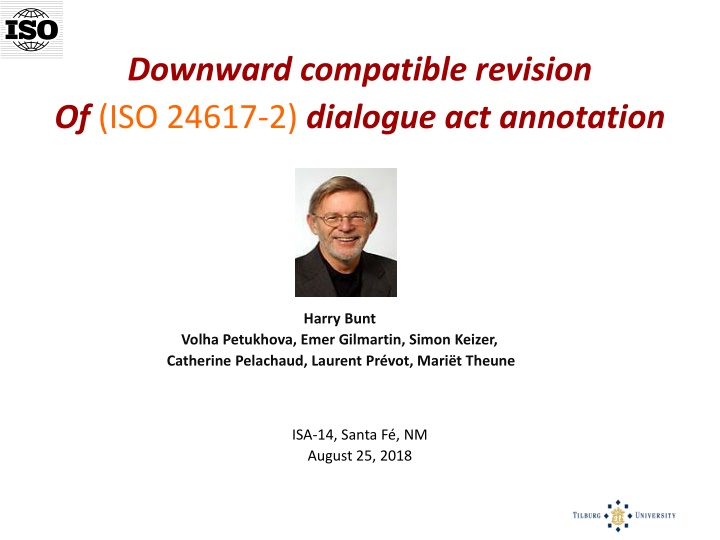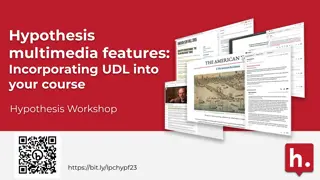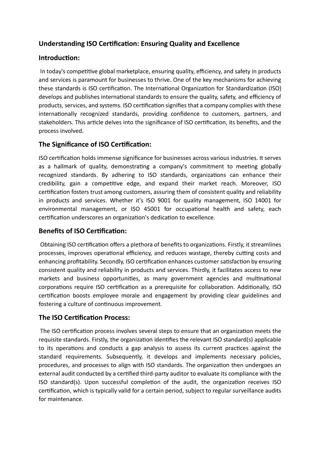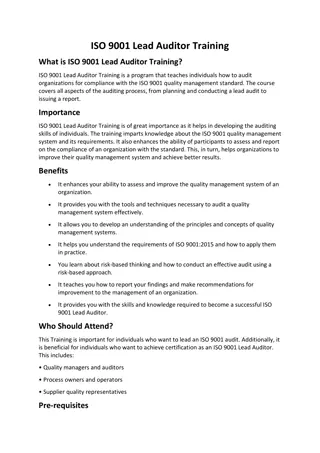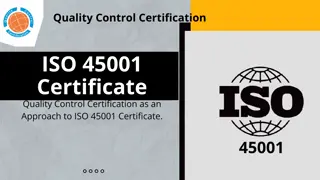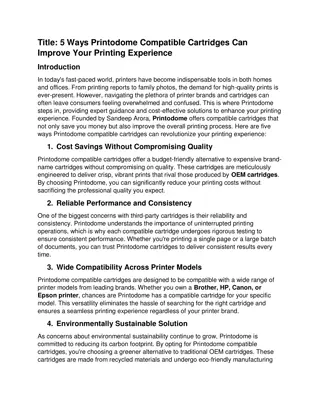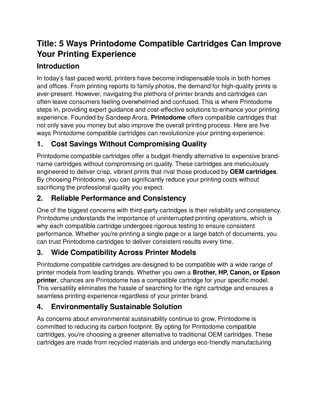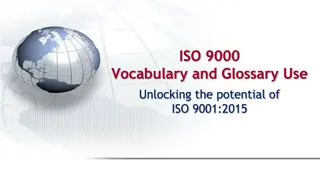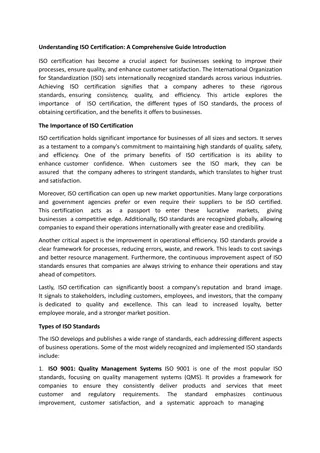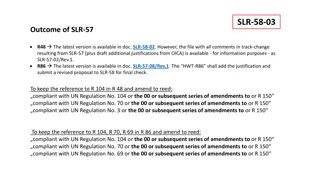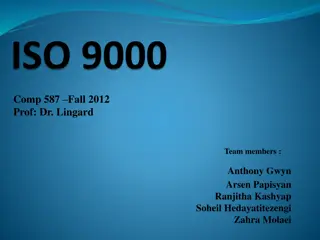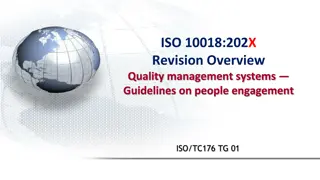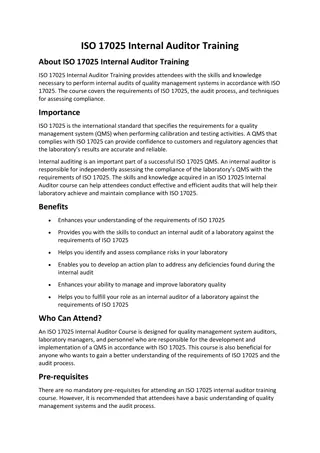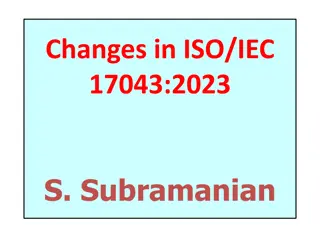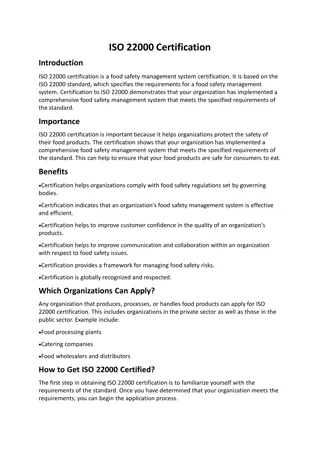Downward Compatible Revision of ISO 24617-2 Dialogue Act Annotation
The downward compatible revision of ISO 24617-2 focuses on characteristics, limitations, compatibility, improvements, and extensions of the dialogue act annotation scheme. It provides a comprehensive taxonomy of dialogue acts, covering various dimensions of communication such as task management, feedback mechanisms, turn and time management, discourse structuring, and more. The revision also highlights the functional and feedback dependence relations between different dialogue acts, offering valuable insights for enhancing communication processes.
Download Presentation

Please find below an Image/Link to download the presentation.
The content on the website is provided AS IS for your information and personal use only. It may not be sold, licensed, or shared on other websites without obtaining consent from the author.If you encounter any issues during the download, it is possible that the publisher has removed the file from their server.
You are allowed to download the files provided on this website for personal or commercial use, subject to the condition that they are used lawfully. All files are the property of their respective owners.
The content on the website is provided AS IS for your information and personal use only. It may not be sold, licensed, or shared on other websites without obtaining consent from the author.
E N D
Presentation Transcript
Downward compatible revision Of (ISO 24617-2) dialogue act annotation Harry Bunt Volha Petukhova, Emer Gilmartin, Simon Keizer, Catherine Pelachaud, Laurent Pr vot, Mari t Theune ISA-14, Santa F , NM August 25, 2018
outline 1. Introduction 2. Characteristics of the ISO 24617-2 dialogue act annotation scheme 3. Limitations of ISO 24617-2: Inaccuracies Desirable extensions 4. Compatibility of annotation schema revision 5. Downward compatible improvements and extensions 6. Concluding remarks
outline 1. Introduction 2. Characteristics of the ISO 24617-2 dialogue act annotation scheme 3. Limitations of ISO 24617-2: Inaccuracies Desirable extensions 4. Compatibility of annotation schema revision 5. Downward compatible improvements and extensions 6. Concluding remarks
ISO 24617-2 Comprehensive, domain-independent taxonomy of dialogue acts Dialogue acts defined semantically as update operators applied to participants information states Dialogue utterances may be multifunctional, due to multiplicity of tasks in communicating Dialogue annotation is multidimensional, assigning multiple communicative functions to functional segments of dialogue in multiple dimensions Taxonomy is organized according to DIT++ dimensions of communication
ISO/DIT++ dimensions Task: dialogue acts moving the underlying task/activity forward Auto-Feedback: providing information about speaker's processing of previous utterances Allo-Feedback: providing or eliciting information about addressee's processing of previous utterances Turn Management: allocation of speaker role Time Management: managing use of time Discourse Structuring: explicitly structuring the dialogue Own Communication Management: editing one's own speech Partner Communication Management: editing addressee's speech Social Obligations Management: dealing with social conventions (greeting, thanking, apologizing,..) 1. 2. 3. 4. 5. 6. 7. 8. 9. Contact Management: monitoring and maintaining/ending contact 10.
Other features of ISO 24617-2 Qualifiers, e.g. for sentiment and certainty Functional dependence relations between dialogue acts (e.g. Answer Question, Confirmation Check Question) Feedback dependence relations between a feedback act and its antecedent dialogue act Rhetorical relations between dialogue acts
Other features of ISO 24617-2 Qualifiers, e.g. for sentiment and certainty Functional dependence relations (e.g. Answer Question, Confirmation Check Question) Feedback dependence relations between a feedback act and its antecedent dialogue act Rhetorical relations between dialogue acts Annotation language DiAML (Dialogue Act Markup Language) with Abstract syntax (annotations as pairs, triples, ) Concrete syntax defining (XML)-representations Semantics in terms of information-state updates defined for the abstract syntax
outline 1. Introduction 2. Characteristics of the ISO 24617-2 dialogue act annotation scheme 3. Limitations of ISO 24617-2: Inaccuracies Desirable extensions 4. Compatibility of annotation schema revision 5. Compatible improvements and extensions 6. Concluding remarks
Inaccuracies in ISO 24617-2 1. Annotation of the scope of feedback acts, own communication management acts, and partner communication management acts Indication of the direction of rhetorical relations Distinction between semantic and pragmatic variants of rhetorical relations 2. 3.
Annotation of Feedback P1: What time is the first train on Sunday to the Airport? P2: The first train is at 6.15, I believe. <diaml xmlns:"http://www.iso.org/diaml/"> <dialogueAct xml:id="da1" target= #fs1 sender="#p1" addressee="#p2 communicativeFunction="setQuestion" dimension="task /> <dialogueAct xml:id="da2" target="#fs2 sender="#p2" addressee="#p1 communicativeFunction="autoPositive dimension="autoFeedback feedbackDependence= #da1"/> <dialogueAct xml:id="da3" target="#fs3 sender="#p2" addressee="#p1 communicativeFunction="answer dimension="task" certainty="uncertain functionalDependence="#da1"/> </diaml>
Annotation of Feedback ISO 24617-2: the antecedent of a feedback act is either a dialogue act or a functional segment. P2: What day do you want to travel? P1: I would like to travel Tuesday evening. What time do you have a flight? P2: TUEsday? Current ISO 24617-2 annotation: feedback dependence to entire functional segment: I would like to travel Tuesday evening (or to its interpretation as a dialogue act). Note: current annotation is not entirely wrong, but inaccurate (negative feedback is not about P1 s entire question).
Speech editing Similarly for own speech editing ( Own/Partner Communication Management ): A: I m a, uhm, I m pretty much a news junkie Self-correction
Rhetorical relations in DiAML 1. P1: Where would you position the buttons? 2. P1: I think that has an impact on many things. <dialogueAct xml:id= da1 target= #fs1 sender= `#p1 addressee= #p2 communicativeFunction= setQuestion dimension= task /> <dialogueAct xml:id= da2 target= #fs2 sender= #p1 addressee= #p2 communicativeFunction= inform dimension= task /> <rhetoricalLink dact= #da2 rhetoRelatum= #da1 rhetoRel= cause /> Limitations: 1. No distinction between roles of arguments of rhetorical relation 2. No distinction between semantic and pragmatic variants of rhetorical relations
Roles in rhetorical relations Direction of rhetorical relation: Result-Reason: 1. Where would you position the buttons? 2. I think that has an impact on many things. Reason-Result: 1. The position of the buttons has an impact on many things. 2. A: Where would you put them?
Rhetorical relations in DiAML 1. P1: Have you seen Pete today? 2a. P2: No, he s not coming in; he has the flu. [ semantic cause ] 2a. P2: No, he s not coming in; he sent me a message saying that he has the flu. [ pragmatic cause ] Current annotation in ISO 24717-2 is not wrong, but not quite expressive enough to allow accurate semantics.
Extensions of ISO 24617-2 Dimensions Contact Management (DIT++) Task Management (DAMSL) Communicative functions: More fine-grained feedback functions More fine-grained social obligations management Functions Domain-specific functions Qualifiers for expression of emotion
Extensions vs Restrictions ISO 24617-2 is restrictable : A dimension (and the corresponding set of dimension-specific communicative functions) may be left out of consideration; by virtue of the orthogonality of the dimensions, this has no influence on the remaining dimensions. Communicative functions may be left out of consideration for which there is a less specific function in the taxonomy. Similarly for additional qualifiers. => ISO 24617-2 is restrictable and therefore extensible.
Additional dimensions and communicative functions Task Management dimension: A: First, let me explain the rules. I am a very famous person. G: Okay. A: You have to guess my name. G: Okay. A: You can ask several questions except for one about my name. (Dialogue fragment from DBOX corpus.)
Additional dimensions and communicative functions Need for Contact Management dimension, and/or for additional Social Obligations Management functions: A: Hi. B: Hello, I m Ann. I m from Mexico city. Yourself? A: Hi Ann, nice to meet you. I m John. B: Hey John, nice to meet you too. How are you today? A: Good, good. You? I m from Paris, living in London now. B: I m in good form! (Dialogue fragment from ADELE corpus.)
outline 1. Introduction 2. Characteristics of the ISO 24617-2 dialogue act annotation scheme 3. Limitations of ISO 24617-2: Inaccuracies Desirable extensions 4. Compatibility of annotation schema revision 5. Downward compatible improvements and extensions 6. Concluding remarks
Compatibility of schema revision Revision of ISO 24617-2 should allow more accurate annotations without invalidating annotations made with the current version. Edition 2 should be downwards compatible with Edition 1.
Compatibility of schema revision: Optionality Types of optionality: Syntactic: non-obligatory element in annotation representation with default value in abstract annotation structure. Semantic: non-obligatory element in abstract annotation structure. Uninterpreted: non-obligatory element in annotation representation, no corresponding element in annotation structure.
Compatibility of schema revision: Optionality Types of optionality: Syntactic: non-obligatory element in annotation representation with default value in abstract annotation structure. Semantic: non-obligatory element in abstract annotation structure. Uninterpreted: non-obligatory element in annotation representation, no corresponding element in annotation structure.
Compatibility of schema revision: Optionality Types of optionality: Syntactic: non-obligatory element in annotation representation with default value in abstract annotation structure. Example: <event polarity= positive /> in ISO-TimeML Semantic: non-obligatory element in abstract annotation structure. Example: Dialogue act = <S,A,H,d,f,q,R> or <S,A,d,f,q>. Uninterpreted: non-obligatory element in annotation representation, no corresponding element in annotation structure. Example: <event pos= verb /> in ISO-TimeML
Optional elements in ISO 24617-2 Syntactic: Qualifiers Certainty certain ; Conditionality unconditional Semantic: There may be no other participants There may be no functional dependencies There may be no feedback dependencies No rhetorical relations have to be specified No specific set of rhetorical relations is assumed Sentiment qualifiers: no specific set of values is assumed Uninterpreted: --
outline 1. Introduction 2. Characteristics of the ISO 24617-2 dialogue act annotation scheme 3. Limitations of ISO 24617-2: Inaccuracies Desirable extensions 4. Compatibility of annotation schema revision 5. Downward compatible improvements and extensions 6. Concluding remarks
Improvement 1: Annotation of Feedback 2. P1: I would like to travel Tuesday evening. What time do you have a flight? 3. P2: TUESday? Current ISO 24617-2 annotation: feedback dependence to entire functional segment: I would like to travel Tuesday evening (or to its interpretation as a dialogue act). Revision: antecedent of feedback can be any segment in the dialogue. <dialogueAct xml:id="da4" target="#fs4 sender="#p2" addressee="#p1 communicativeFunction="autoPositive dimension="autoFeedback feedbackDependence= #rs1"/>
Improvement 2: Rhetorical relations Annotation in ISO 24617-8 ( DRelML ): 1. P1: Have you seen Pete today? 2a. P2: No, he s not coming in; he has the flu. [ semantic cause ] 2b. P2: No, he s not coming in; he sent me a message saying that he has the flu. [ pragmatic cause ] . . 2a: <drArg xml:id= e2 target= #fs2 argType= event /> <drArg xml:id= e3 target= #fs3 argType= event /> <drLink reason= #e3 result= #e2 rel= cause /> . . 2b: <drArg xml:id= e2 target= #fs2 argType= dialogAct /> <drArg xml:id= e3 target= #fs3 argType= event /> <drLink reason= #e3 result= #e2 rel= cause />
Combining ideas from DRelML and DiAML 1. P1: Have you seen Pete today? 2. P2: He s not coming in; he s still suffering from the flu. [ semantic cause ] Combination: addition of non-obligatory attribute semanticContent , as a semantic option. <dialogueAct xml:id= da2 target= #fs2 sender= #p2 semanticContent= #e2 /> <event xml:id=e2 target= #fs2 /> <dialogueAct xml:id= da3 target= #fs3 sender= #p2 semanticContent= #e3 /> <event xml:id=e3 target= #fs3 /> <drLink reason= #e3 result= #da2 rel= cause />
Combining ideas from DRelML and DiAML 1. P1: Have you seen Pete today? 2. P2: He s not coming in; he s still suffering from the flu. [ semantic cause ] Combination: addition of non-obligatory attribute semanticContent , as a semantic option. . <dialogueAct xml:id= da2 target= #fs2 sender= #p2 semanticContent= #e2 /> <event xml:id=e2 target= #fs2 polarity= neg /> <dialogueAct xml:id= da3 target= #fs3 sender= #p2 semanticContent= #e3 /> <event xml:id=e3 target= #fs3 /> <drLink reason= #e3 result= #e2 rel= cause /> To avoid built-in assumptions about possible rhetorical relations: <drLink arg1= #e3 arg1Role= reason arg2= #e2 arg2Role= result rel= cause />
Combining ideas from DRelML and DiAML 1. P1: Have you seen Pete today? 2. P2: He s not coming in; he s still suffering from the flu. [ semantic cause ] Combination: addition of non-obligatory attribute semanticContent , as a semantic option. . <dialogueAct xml:id= da2 target= #fs2 sender= #p2 semanticContent= #e2 /> <event xml:id=e2 target= #fs2 polarity= neg /> <dialogueAct xml:id= da3 target= #fs3 sender= #p2 semanticContent= #e3 /> <event xml:id=e3 target= #fs3 /> <drLink reason= #e3 result= #e2 rel= cause /> To avoid built-in assumptions about possible rhetorical relations: <drLink arg1= #e3 arg1Role= reason arg2= #e2 arg2Role= result rel= cause /> Extensions: @semanticContent; use of @event; use of drLink all optional
Concluding remarks ISO 24617-2 supports the annotation of rich dialogue act information, at different possible levels of granularity due to the hierarchical structure of the inventory of communicative functions, the orthogonal dimensions, functional and feedback dependence relations, and the optional use of qualifiers and rhetorical relations. The ISO 24617-2 annotation scheme and markup language DiAML have been used successfully, but building the DialogBank, DBOX, and other corpora has revealed certain inaccuracies and undesirable limitations. The inaccuracies and limitations can be resolved in a downward compatible way by introducing the optional use of non-functional segments, additional dimensions and communicative functions, and the use of concepts from other ISO annotation schemes.
